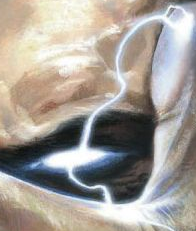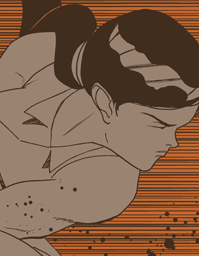Deadshirt Is Reading… is a weekly feature in which Deadshirt’s staff, contributing writers, and friends-of-the-site offer their thoughts on Big Two cape titles, creator-owned books, webcomics and more. For more of our thoughts on this week’s new comics, take a look at Wednesday’s Deadshirt Comics Shopping List.
Kayleigh Hearn is Reading…
Written by Grant Morrison and Peter Milligan
Art by Joe Quesada and Mike Allred
Lettering by Chris Eliopoulos and Travis Lanham
Marvel
“Well, recently I’ve gotten to wondering…how things would be…if they got more serious.”
It was perhaps impossible for All-New Miracleman Annual to live up to the hype.
Miracleman Annual boasts the first new Miracleman material in decades—something fans have been salivating for since Marvel Comics acquired the rights to the Marvelman/Miracleman series years ago—as well as a “long lost” story by superstar writer Grant Morrison, originally scripted in 1984. Considering all of this, as well as Morrison’s now-infamous feud with “The Original Writer” Alan Moore, it’s difficult not to want “The October Incident: 1966” to be bigger, grander, deeper than it actually is.
Morrison crafts a simple, straightforward story about Johnny Bates, the deranged Kid Miracleman, encountering a priest on a beach with horrific results. At eleven pages, it’s a solid but unremarkable story with fairly pedestrian references to Hamlet and Nietzsche. Joe Quesada’s art elevates the story to something crisp and modern, rather than a relic of a bygone year. He draws Johnny Bates as the dark reflection of another John, John Lennon, but Bates is more interested in terror and annihilation than singing about peace and love. (There’s also a bit of Grant Morrison himself in Quesada’s Kid Miracleman, as a photo of the writer in the issue’s behind-the-scenes extras shows.) The Annual is an important work for Morrison completists, but it is nowhere near in the heights Morrison would achieve in the 30 years after this story was written.
Far more successful is the annual’s second story, “Seriously Miraculous” by Peter Milligan and Mike Allred. This creative team continually brings out the best in each other, and this story straddles the line between the cheery 1950s nonsense of the original Mick Anglo “Marvelman Family” stories and Alan Moore’s dark deconstruction of that universe. Unknowingly trapped inside the colorful dreamworld created by Dr. Gargunza, Miracleman and his pals face ridiculous menaces such as Young Nastyman and evil flying dolphins. Miracleman comes dangerously close to realizing that their adventures are fiction, but is then overcome by cheerful obliviousness. You can’t really blame him; knowing what future issues hold, how tempting it must be to stay in a dream where violence never leaves collateral damage, and nothing is more serious than a cliché “BIF!” sound effect.
“Seriously Miraculous” is charming and clever, and if it doesn’t quite break the fourth wall, it gives it a good hard knock. It’s also really, really funny, in a way Miracleman stories are rarely allowed to be. (Mike Allred’s sneering and squinty-eyed flying dolphins are the most hilarious things I’ve seen in a long time.) Milligan and Allred’s story foretells good things for Marvel’s new Miracleman stories, even if Young Miracleman’s plaintive “How serious do you want it?” could poke fun not only at Moore’s dark series, but also the Grant Morrison story that directly preceded it.
Sarah Register is reading…
Written by Mark Waid
Pencils by Carlos Pacheco
Inked by Mariano Taibo with Jason Paz
Colored by Dono Almara
Lettered by Joe Caramagna
Marvel
“Hell of a first day on the job…”
Select members of the team from the hit Agents of S.H.I.E.L.D. television show join Phil Coulson in their first comic book appearance in the Marvel comics universe. What probably started as a pitch for non-comic reading fans of the show ends up as a predictable love letter to Coulson himself, a man who is already rich with fan adoration. Even the artwork recognizes his face as Clark Gregg, but the other silver screen characters are drawn more generically. His personality and backstory seems to jump between the MCU canon and comic book continuity, but the general story ends up being accessible to fans of either or both.
With so much of the focus, both from the writing and the art, on Coulson, agents May, Fitz, and Simmons are less shiny in their book debut. Considering the audacious scope of this first issue, that’s to be expected. All of Marvel’s heavy-hitters show up on the team’s first day as S.H.I.E.L.D.’s special ops team. Carlos Pacheco fills every nook and cranny with layered action as Avengers clash with baddies in the background, and that’s the thing about this comic: all of the major title characters live in the background while, unimpressed by the grandiosity of even the gods, Coulson runs the operation.
I’m always weary of comics that push out one-shot adventures, but this first issue was fun. Despite the predictable (but enjoyable) nature of Coulson being generally awesome, it was Fitz’s interactions with superheroes that felt funny and fresh, especially when he mistook Valkyrie for the new lady Thor. Mark Waid really knows how to produce a comic that is both entertaining and clever, so as long as readers know what they’re getting into, they’ll be amused.
David Uzumeri is reading…
Written by Jonathan Hickman
Art by Nick Dragotta
Colored by Frank Martin
Lettered by Rus Wooton
Image
“A people were conquered here… how cool is that?”
The second year of East of West begins with a tonal shift and a bang, as the hidden alliances and backroom-dealing skullduggery of the book’s first act give way to overt hostilities and lots of people getting shot in the face. The big cliffhanger of the end of Year One (the year in the book’s timeline, by the way, not ours)—the Beast of the Apocalypse, Death, and Premier Xiaolian Mao’s son, free and wandering the wastelands of America—doesn’t get picked up here, but instead we get a very quick escalation of action and some more exciting times with our favorite sadistic Elementary School Kids of the Apocalypse.
We spend some time catching up with the Endless Nation’s war on the other territories, as alliances are forged and republics are conquered. The whole thing is rendered with the same amazing juxtaposition of Hickman’s dark, cynical wit, Dragotta’s clean, stylized linework, and Martin’s oppressive yet vibrant colors that have been the book’s trademark thus far—in short, if you’ve been enjoying it up to now, you’re not going to want to turn away here. If you haven’t been reading it, this isn’t the place to start; like all of Hickman’s work, both long- and short-form, it’s a complexly constructed plot with interconnected intrigues and generous foreshadowing that demands more than suggests being experienced as a whole. Indeed, my main takeaway (even after this month’s catch-up atlas, East of West: The World) is that I should (and will) go back and reread the series so far.
That said, it’s the kind of book where the idea of rereading it from the beginning feels like a treat, not homework. It’s a murderous, apocalyptic sci-fi political western with eight-year-olds drinking blood out of human skulls, scavenger sheriff robot dogs and totem poles made out of death-dealing futuristic weaponry. It’s a serious book that doesn’t take itself too seriously. I like it a lot.
Thanks for reading about what we’re reading! We’ll be back next week with a slew of suggestions from across the comics spectrum. In the meantime, what are you reading? Tell us in the comments section, on Twitter or on our Facebook Page!




